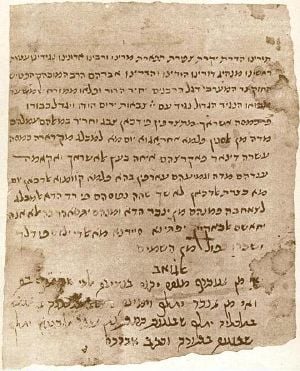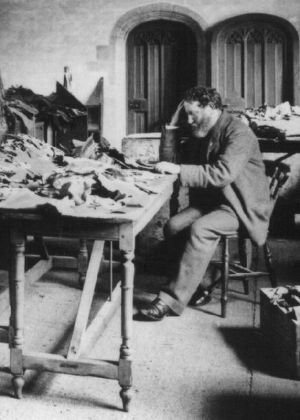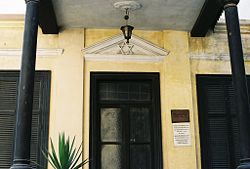Cairo Geniza

The Cairo geniza was a storeroom in a synagogue in Cairo, Egypt, in which almost 200,000 Jewish medieval manuscripts were discovered. It is considered among the greatest archaeological finds of the modern era, providing many unique insights into Jewish and Middle Eastern history during a period of more than a thousand years.
Although the existence of the geniza (a Hebrew word meaning a "hiding place" for worn, damaged, or unauthorized documents) was known from the mid-nineteenth century, the Jewish scholar Solomon Schechter is generally credited with uncovering and analyzing the treasure trove of medieval documents that lay there, many untouched for centuries, beginning in 1896. The vast collection came to be housed in several university libraries and received careful study over the next century, revealing a great deal of information valuable both to the religious history of Judaism and to the general study of Middle Eastern society in the medieval period. Among the geniza's treasures were the first known copy of the Book of Ecclesiasticus in Hebrew, documents related to the history of the Karaite Jews and Khazars, Talmudic and Jewish liturgical works, Arabic poetry and medical texts, legal responsa and philosophical writers, many personal and business documents, and the so-called Zadokite Fragments later also discovered among the Dead Sea Scrolls.
The term "Cairo Geniza" also refers to a wider collection of documents, including those found at the geniza of Ben Ezra Synagogue itself, as well as discarded documents buried in the Basatin cemetery east of Old Cairo, and a number of related texts bought in the Cairo antiquities market in the later nineteenth century.
Discovery
A geniza is a storeroom or depository in a synagogue, a literary cemetery in which worn-out scriptures are placed and heretical or disgraced Hebrew writings are stored so as to prevent their circulation. The Cairo geniza was of medieval origin, as the area bought and renovated the destroyed Coptic church in 882, turning it into the Ben Ezra Synagogue. Cairo was a prominent center of Middle Eastern political, economic, and cultural life, and the Jewish community of Cairo consequently was a very significant one.
The German traveler and book dealer Simon von Geldern is the first known modern western visitor to the Cairo geniza, having visited the Ben Ezra Synagogue in 1753 and mentioning the geniza in his 1773 book, The Israelites on Mount Horeb. However, local superstition prevented von Geldern from examining the geniza's contents. The potential of the geniza of the Ben Ezra Synagogue as a significant subject of research was first recognized by the Jewish writer and traveler Jacob Saphir in the mid 1800s. After growing up in Safed, in 1848 he was commissioned by the Jewish community of Jerusalem to collect alms for the city's poor from the Jewish residents of the countries to the south and made several subsequent journeys to Cairo. In his Eben Sappir Shaphir describes how he spent two days ferreting among the ancient books and leaves till the dust and ashes caused him to become ill. "Who knows what may yet be beneath?" he asked. In the late nineteenth century, Russian Jews Abraham Firkovich and Albert Harkavy succeed in obtaining documents form a nearby Karaite geniza, in an effort to research the history of Karaite Judaism.
The Cairo geniza seems to have become vitually lost in the following decades. In 1888, the collector and author Elkan Nathan Adler visited the synagogue but did not succeed in seeing more than a recess in the upper part of the right wall containing a scroll of Book of Ezra and a few other ancient manuscripts. The normal practice for genizas was to periodically remove the contents and bury them in a cemetery, and apparently the geniza had been sealed after one of these removals. Adler was informed that all old manuscripts were buried in the Jewish cemetery at Basatin.
Shortly afterward, the synagogue was repaired by the Jews of Cairo, and during its renovation the old storeroom was rediscovered, being a secret chamber approached from the farthest extremity of the gallery by climbing a ladder and entering through a hole in the wall. During his visits to Cairo in 1888 and 1896 Adler collected and brought over 25,000 Genizah manuscript fragments back to England. Adler's greatest find took place in January 1896 under the escort of the synagogue's chief rabbi, Rafaïl ben Shimon ha-Kohen, who allowed him to take away with him a sack containing all the parchment and paper fragments they had been able to gather in about four hours. Some of these turned out to be of exceptional interest, and were published shortly afterward.
The English archaeologist Henry Archibald Sayce, who wintered in Cairo for reasons of his health, also visited the synagogue, but he found that many of its contents had been buried. However, Sayce was able to acquire many fragments from the synagogue's caretakers, which were later stored in the Bodleian Library of Oxford University. Other libraries made similar acquisitions. The American Cyrus Adler secured about 40 pieces from a dealer in 1891, and additional pieces were purchased on the antiquities market by various other researches.

It was the identification of a text of Ben Sira among the Bodleian fragments which induced Solomon Schechter to proceed to Cairo in the autumn on 1896 and bring back with him practically the entire written contents of the genizah. Two Christian researchers associated with Cambridge University showed Schechter, who was at the time was a professor of Talmudic and rabbinical literature at Cambridge several intriguing fragments from the geniza. Schechter was able to determine that they were part of the previously unknown Hebrew original of Ben Sira's Book of Wisdom, which had been accepted into the Christian canon and was known primarily as Ecclesiasticus in Catholic Bibles. No Hebrew version of this work was previously known and some scholars believed it to have been composed originally in Greek. Schechter then received a grant enabling him to lead an expedition to Egypt, where he carefully went through the Cairo geniza and returned to Cairo with thousands of pages from the genizah. These now constitute the bulk of the collection at the Cambridge University Library.
The documents have now been archived in various American and European libraries. The Taylor-Schechter collection in the University of Cambridge runs to 140,000 manuscripts; there are a further 40,000 manuscripts at the Jewish Theological Seminary of America. Also, the John Rylands University Library in Manchester, Egnland holds a collection of over 11,000 fragments, which are currently being digitized and uploaded to an online archive.
Contents and significance
The documents of the Cairo geniza were written from about 870 C.E. to as late as 1880. Although known of them can be considered truly ancient, many represent copies of ancient documents, some of which were not previously known and have proven to be of great significance. Many of the documents are secular in nature as well, revealing previously unknown facts about Jewish and Egyptian life over a period of more than a millennium. Their discovery is often likened later, and much more famous discovery of the Dead Sea Scrolls.
Schecter's work on Ben Sirah brought considerable attention to the find just before the turn of the twentieth century. His the Saadyana]] (1903) revealed substantial new light from the geniza on the work of the great medieval Jewish rabbi and philosopher Saadia Gaon. His Documents of Jewish Sectaries (1910), dealing with a previously unknown first-century sect now thought probably to be the Essenes, proved especially significant after fragments of the same document turned up among the Dead Sea Scrolls, proving that the documents which Schechter found at the geniza were indeed copies of texts from around the turn of the Common Era, as he had suspected.
The geniza also contained copies of Greek translations of the Bible by Aquila of Sinope, who originally worked c. 130 C.E. Ancient Jewish liturgical prayers of both Babylonian and Spanish origin were also uncovered, as well as a great deal of material dealing with the history and traditions of Karaites. A tenth century letter from Kiev constitutes the earliest known evidence Jews living in the Ukraine. The geniza also shone new light on the conversion of the conversion to Judaism of the kingdom of the Khazars from the ninth century onward. Yiddish letters and poems from the thirteenth to fifteenth centuries were also discovered at the geniza.
Many of the geniza documents were written in the Arabic language using the Hebrew alphabet. As Hebrew was considered the language of God by the Jews, the texts could not be destroyed even long after they had served their purpose. The documents are invaluable as evidence for how colloquial Arabic of this period was spoken and understood.
Many of the documents are of value more to sociologists than religious scholars, demonstrating how the Jews of Cairo related to their contemporary society. Indeed, the importance of these materials for reconstructing the social and economic history of medieval Egypt and the Middle East cannot be overemphasized. For example the geniza documents include a unique romantic tale of Umayyid caliph Al-Walid II, from the mid-eighth century. It also contains the only copies of the pharmacological work of eleventh century physician Ahmed Ibn Al-Djazzar. The geniza provided a great deal of previously unknown information about the rule of the Ayyubid sultans in the twelfth and thirteenth centuries, showing as well the role that the Jews of the period played in Cairo's life and culture. They show that the Jewis of Cairo practiced the same trades as their Muslim and Christian neighbors, including farming. They also bought, sold, and rented properties to and from their Gentile contemporaries.
An index created by the scholar Shelomo Dov Goitein covers about 35,000 individuals named in the documents, including about 350 "prominent people," including Maimonides (who moved to Cairo late in life) and his son Abraham); 200 "better known families;" and mentions of 450 professions and 450 trade goods. Goitein identified material from Egypt, Palestine, Lebanon, Syria (but not Damascus or Aleppo), Tunisia, Sicily, and even covering trade with India. Cities mentioned range from Samarkand in Central Asia to Seville and Sijilmasa, Morocco to the west; from Aden north to Constantinople; Europe not only is represented by the Mediterranean port cities of Narbonne, Marseilles, Genoa and Venice, but even Kiev and Rouen are occasionally mentioned.
The materials include a vast number of books, most of them fragments, which Goitein estimated number 250,000 leaves, including parts of Jewish religious writings and fragments from the Qur'an. Of particular interest to biblical scholars are several incomplete manuscripts of Sirach in Hebrew, which had been known only in Greek prior to the geniza discovery.
Goitein remarks that the number of documents dropped in number about the 1266 and saw a rise around 1500, when the local community was increased by refugees from Spain. It was they who brought to Cairo several documents that shed a new light on the history of Khazaria and Kievan Rus.
See also
ReferencesISBN links support NWE through referral fees
- Goitein, Shelomo DovA Mediterranean Society: The Jewish Communities of the Arab World as Portrayed in the Documents of the Cairo Geniza,
External links
- The Genizah Project
- Rylands Genizah Project
- Princeton Geniza Project Website
- A Window into Jewish Medieval Life
- University of Cambridge Taylor-Shechter Geniza Research Unit
- Penn/Cambridge Genizah Fragment Project
Credits
New World Encyclopedia writers and editors rewrote and completed the Wikipedia article in accordance with New World Encyclopedia standards. This article abides by terms of the Creative Commons CC-by-sa 3.0 License (CC-by-sa), which may be used and disseminated with proper attribution. Credit is due under the terms of this license that can reference both the New World Encyclopedia contributors and the selfless volunteer contributors of the Wikimedia Foundation. To cite this article click here for a list of acceptable citing formats.The history of earlier contributions by wikipedians is accessible to researchers here:
The history of this article since it was imported to New World Encyclopedia:
Note: Some restrictions may apply to use of individual images which are separately licensed.

